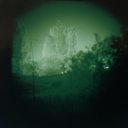About the Work
From a safe distance, as if through night vision goggles, the nocturnal observer filters buildings and trees schematically into the photo memory. What happens at the scene of the crime is unknown. In complete contrast to the uniformly sealed single-family houses from Thomas Ruff's early years or his smoothed passport photo and profile faces on large portrait pictures of family and friends, the contours become blurred. The first successor to Bernd and Hilla Becher's chair at the Düsseldorf Art Academy has been zooming in on motifs since 1992. Perception should remain as blurred as the photo − just as imprecise as the uncertain event in the bushes through which the wind blows in Michelangelo Antonioni's epochal film: Blow up! What happens or could have happened in Thomas Ruff's conceptual photography depends on the viewer's sense of sight. When it gets light, architectural icons by Mies van der Rohe or porn scenes retrieved from the Internet seem to slide onto the lens of a frosted glass lens. Nothing is real yet. As in the age pictures of action painter Willem de Kooning, the contours lose themselves in a black and white as well as coloured curvature.
